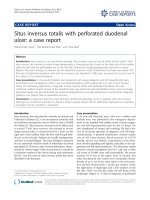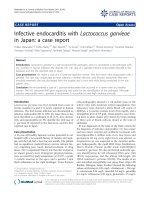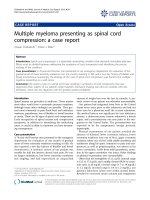Báo cáo y học: "Fixed drug eruption resulting from fluconazole use: a case report" pptx
Bạn đang xem bản rút gọn của tài liệu. Xem và tải ngay bản đầy đủ của tài liệu tại đây (2.92 MB, 4 trang )
Case report
Open Access
Fixed drug eruption resulting from fluconazole use: a case report
Mahkam Tavallaee
1
* and Mahnaz Mahmoudi Rad
2
Addresses:
1
Department of Health Sciences, Simon Fraser University, Burnaby, Canada V5A 1S6 and
2
Skin Research Center, Shaheed Beheshti
University of Medical Sciences and Health Services, Tehran, Iran
Email: MT* - ; MMR -
* Corresponding author
Received: 27 November 2008 Accepted: 29 January 2009 Published: 6 July 2009
Journal of Medical Case Reports 2009, 3:7368 doi: 10.4076/1752-1947-3-7368
This article is available from: />© 2009 Tavallaee and Rad; licensee Cases Network Ltd.
This is an Open Access article distributed under the terms of the Creative Commons Attribution License (
/>which permits unrestricted use, distribution, and reproduction in any medium, provided the original work is properly cited.
Abstract
Introduction: Fluconazole is a widely used antifungal agent with a possible side effect of fixed drug
eruption. However, this adverse drug effect is absent from the reported list of possible side effects of
fluconazole. We are presenting a rare case in our report.
Case presentation: A 25-year-old Iranian woman developed fixed drug eruptions on different sites
of her body after taking five doses of fluconazole to treat vaginal candidiasis. A positive patch test,
positive oral challenge test and skin biopsy were all found to be consistent with fixed drug eruption.
Conclusion: Fluconazole is a widely prescribed drug, used mainly to treat candidiasis. Fixed drug
eruption as a possible side effect of Fluconazole is not well known and thus, the lesions may be
misdiagnosed and mistreated. Based on our findings, which are consistent with a number of other
practitioners, we recommend adding fixed drug eruption to the list of possible side effects of
fluconazole.
Introduction
Fluconazole (Diflucan®) is a broadly used bis-triazole
antifungal agent. It functions mainly by inhibiting
cytochrome P45014a-demethylase (P45014DM), which
in turn, prevents the conversion of lanosterol to ergosterol
in the sterol biosynthesis pathway. Fluconazole seems to
have a superior selectivity for fungus compared to human
P-450-enzymes [1]. It is used to treat vaginal, orophar-
yngeal, and esophageal candidiasis; additionally, it is used
to treat cryptococcal meningitis and prevent fungal
infections in immunocompromised patients. In some
literature, fluconazole has proven to be effective for
treatment of Candida urinary tract infections, peritonitis,
and systemic Candida infections including candidemia,
disseminated candidiasis, and pneumonia [2]. The body
clears fluconazole primarily by renal excretion. Accord-
ingly, the dosage should be reduced in proportion to any
reduction in kidney function. In general, the body tolerates
fluconazole quite well. Still, there are commonly observed
adverse events such as nausea, vomiting and elevations in
liver function tests. Less common side effects are head-
aches, dizziness, diarrhea, stomach pain, heartburn,
change in ability to taste food, an upset stomach, extreme
fatigue, appetite loss, pain in the right upper quadrant,
jaundice, dark urine, pale stools, flu-like symptoms and
seizures. Observed hypersensitivity reactions are anaphy-
lactic reactions, angioedema and facial edema, pruritus,
urticaria, erythematous or maculopa pular rash and
Page 1 of 4
(page number not for citation purposes)
exfoliative skin reactions, including Stevens Johnson
Syndrome (SJS) and toxic epidermal necrolysis [3].
Fixed drug eruption (FDE) is characterized by single or
multiple skin lesions that occur at the same site each time a
drug is administered. However, the number and size of
sites may increase after each exposure. Lesions are usually
round or oval and well defined. Swelling and redness of
skin are typically seen within 30 minutes to eight hours
after exposure. Lesions are more commonly seen in the
extremities, genital areas and perianal areas, and may also
appear in other locations such as the mucosal area.
Persistent hyperpigmentation on the site of the lesion is
normally seen after healing. Accompanying systemic
symptoms are mild in FDE. The drugs mostly reported
to cause FDE are: cotrimoxazole, tetracycline, metamizole,
phenylbutazone, paracetamol, acetylsalicylic acid,
NSAIDS, metronidazole, tinidazole, chlormezanone,
amoxicillin, ampicillin, erythromycin, belladonna,
griseofulvin, phenobarbitone, diflunisal, pyrantel pamo-
ate, clindamycin, allopurinol, orphenadrine, albendazole,
dapsone, phenolphthalein, oral contraceptives, phenace-
tin, doxycycline, minocycline, panmycin, sulfonamide,
Figure 1. Fixed drug eruption induced by fluconazole,
upper lip area.
Figure 2. Symmetrical fixed drug eruption on legs due to
fluconazole.
Figure 3. Fixed drug eruption due to fluconazole (right
popliteal area).
Figure 4. Histopathology of skin biopsy (left popliteal area).
Page 2 of 4
(page number not for citation purposes)
Journal of Medical Case Reports 2009, 3:7368 />sulfasalazine, benzodiazepines and chlordiazepoxide,
hyoscine butylbromide, and quinine [3,4].
Case presentation
A 25-year-old woman received five doses of fluconazole
(150 mg) once a month for recurrent vaginal candidiasis.
She was healthy but had a family history of atopic
dermatitis. She noticed a red erythematous macule on the
medial side of her right popliteal fossa after taking her
second dose of fluconazole. With time, the macule faded,
but a violet pigmentation developed. A month later, after
taking another dose, she again developed two macules; one
developed on exactly the same site and the other in the left
popliteal fossa. Both patches were symmetrical and similar
in appearance. Again, the patches faded and hyperpigmen-
ted areas developed. At this point, she was examined by a
dermatologist and misdiagnosed with lichen planus and
treated with topical clobetasol that led to the development
of striae on both sites. Four hours after taking the fifth dose,
the macules reappeared along with a new macule on her
right upper lip. She suspected that the symptoms were
caused by fluconazole and again visited a dermatologist. An
oral challenge test with fluconazole (150 mg) was
conducted 4 weeks later and showed similar signs three
hours after intake. Local provocation was performed with
10% fluconazole in petrolatum on the left pigmented area
and 10% fluconazole in ethanol on the right pigmented
area. For comparison, the same compounds were tested on
normal skin on the back. After 16 hours, two red patches
developed onboth sides of her legsand none on her back. A
skin biopsy specimen from the left popliteal area revealed
a lichenoid infiltrate, a basal cell vacuolization, dermal
melanophages and a superficial perivascular lymphocytic
infiltrate consistent with FDE. Despite having a family
history of atopic dermatitis, she had no major or minor
symptoms of atopic dermatitis and she denied having any
other reaction to drugs or any allergy history. We
recommended that she discontinue using fluconazole.
To determine the cause of the recurrent vaginitis, her
complete medical history was taken. She had experienced
mid cycle spotting while using low-dose oral contra-
ceptives therefore she switched to using high-dose oral
contraceptives 2 years before our study. She was also
working in a fitness center during that time and she
mentioned that she wore a wet swimsuit for long periods
of time and used tight synthetic clothes all of which were
risk factors for vaginal candidiasis [16]. At this time, we
recommended that she use other contraceptive methods
for example, condoms. Furthermore, we asked her to
wear cotton underwear and informed her of preventive
methods of candidiasis. We followed up with her after
6 months and she mentioned she had not experienced
any other episode of candidiasis since then.
Discussion
We discuss a rare case of fixed drug eruption due to
fluconazole. We have found 16 other reports of FDE due to
fluconazole although the site and appearance of the skin
lesions were different among the reported cases. Thirteen
out of 17 cases of FDE due to fluconazole, including ours,
occurred in women [6,8-10,12-14]. Most previous studies
on FDE due to drugs demonstrated a higher occurrence in
men compared to women according to research by
Mahboob and colleagues [4]. Contrarily, in their study,
the ratio of women to men was 1.1:1 [4]. The number of
reported cases of FDE due to fluconazole is too low to be
discussed epidemiologically. However, the higher ratio of
women could be due to the higher prescription of
fluconazole to women due to vaginal candidiasis. The
youngest patient reported was 19-years-old [11] while the
oldest one was 66-years-old [7]. The mean age ± SD of
men who experienced FDE due to drugs in previous
studies was 30.4 ± 17 while it was 31.3 ± 14 for women
[4]. In previous studies of FDE due to fluconazole, all
female patients were prescribed fluconazole for vaginal
candidiasis similar to our patient, while male patients
were prescribed fluconazole for Candida balanitis [5], oral
candidiasis [10], tinea corporis and tinea cruris [11]. In
almost all cases, eruption occurred after a couple of drug
administrations. The only common medication used by
patients was fluconazole. The most affected sites for
eruptions were limbs , palmar and plantar areas
[5,6,8,10,12] as well as the oral cavi ty and lips
[6,8,9,11,14,15]. A report of vulvar FDE due to flucona-
zole has also been published recently [15]. In our patient,
both popliteal fossas and the upper lip were affected.
A study by Sharma and colleagues was conducted on 125
patients who had FDE due to drugs. They reported that the
Figure 5. Histopathology of skin biopsy (left popliteal area).
Page 3 of 4
(page number not for citation purposes)
Journal of Medical Case Reports 2009, 3:7368 />trunk and limbs were the major sites with 24% followed by
lips alone and genitalia with 20.8% and 20%, respectively.
Another study compared 450 cases of FDE and the results
showed that 48% of lesions involved the lips followed by
hands (36.8%), arms (34.6%), and legs (33.3) [4]. They
also reported that 57.6% of patients had multiple lesions
compared to 42.4% who had a single eruption due to use of
drugs [17]. In a study conducted by Mahboob et al, 16.2%
of patients with FDE had solitary lesions compared to the
remaining patients who had more than one lesion [4]. The
same study also showed that 70% of patients with FDE
experienced a bilateral involvement comparable to our
study [4]. To our knowledge, our study is the second
documented case of successful patch testing for fluconazole
[6]. Alanko conducted a topical provocation test on 30
patients with FDEand concluded that thetest is a usefuland
safe method. However, a positive test is more informative
than a negative test in most drug reactions [18]. One study
demonstrated that an oral challenge test is a useful method
as a tolerance test or to exclude drug hypersensitivity in
cases of suspected drug reactions with negative skin tests
[19]. The skin test was positive in our patient. However, we
did an oral test as well that was also positive. This was
consistent with most of the reported cases [5,7,8,10,11,14].
It is important to note that diagnostic tests must be done
carefully to prevent the rare occurrence of toxic epidermal
necrolysis [13]. Skin biopsies were performed in four cases
[5,6,12,14] and the histopathology was consistent with
FDE similar to our patient.
Conclusion
Fluconazole is a broadly administered medication used
mainly to treat candidiasis. FDE is one of the rare side
effects of fluconazole. However, FDE may be misdiag-
nosed and mistreated since many medical practitioners are
unaware of this uncommon side effect. Our findings are
consistent with those from a number of other practi-
tioners, thus, we recommend adding FDE to the list of
possible side effects of fluconazole.
Abbreviations
P45014DM, P45014a-demethylase; SJS, Stevens Johnson
Syndrome; FDE, fixed drug eruption.
Consent
Written informed consent was obtained from the patient
for publication of this case report and any accompanying
images. A copy of the written consent is available for
review by the Editor-in-Chief of this journal.
Competing interests
The authors declare that they have no competing interests.
Authors’ contributions
MT identified the adverse drug reaction, performed the
literature review and wrote the first draft of the paper.
NMR took the biopsy, undertook the histological analysis
and finalized the manuscript. Both authors read and
approved the final manuscript.
Acknowledgements
We are grateful to Linda Apps and Shirin Kiani who helped
in editing this paper. We also wish to thank Kaveh
Sayarirani for his expert help with the images.
References
1. Sweetman S (Ed): Martindale: The Complete Drug Reference. 34th edition.
London: Pharmaceutical Press; 2004.
2. Debruyne D: Clinical pharmacokinetics of fluconazole in
superficial and systemic mycoses. Clin Pharmacokinet 1997,
33:52-77.
3. Litt JZ: Litt's Drug Eruption Reference Manual. 11th edition. London:
Taylor & Francis; 2005.
4. Mahboob A, Haroon TS: Drugs causing fixed eruptions: a study
of 450 cases. Int J Dermatol 1998, 37:833-838.
5. Morgan JM, Carmichael AJ: Fixed drug eruption with fluconazole.
BMJ 1994, 308:454.
6. Heikkila H, Timonen K, Stubb S: Fixed drug eruption due to
fluconazole. J Am Acad Dermatol 2000, 42:883-884.
7. Khandpur S, Reddy BSN: Fixed drug eruptions to two chemically
unrelated antifungal agents. Indian J Dermatol 2000, 45:174-176.
8. Ghislain PD, Ghislain E: Fixed drug eruption due to fluconazole:
a third case. J Am Acad Dermatol 2002, 46:467.
9. Lane JE, Buckthal J, Davis LS: Fixed drug eruption due to
fluconazole. Oral Surg Oral Med Oral Pathol Oral Radiol Endod 2003,
95:129-130.
10. Shukla P, Prabhudesai R: Fixed drug eruption to fluconazole.
Indian J Dermatol 2005, 50:236-237.
11. Mahendra A, Gupta S, Gupta S, Sood S, Kumar P: Oral fixed drug
eruption due to fluconazole. Indian J Dermatol Venereol Leprol
2006, 72:391.
12. Nederlands Bijwerkingen Centrum Lareb. November 2007
Report [ />13. Mockenhaupt M, Viboud C, Dunant A, Naldi L, Halevy S, Bouwes
Bavinck JN, Sidoroff A, Schneck J, Roujeau JC, Flahault A: Stevens-
Johnson syndrome and toxic epidermal necrolysis: assess-
ment of medication risks with emphasis on recently
marketed drugs. The EuroSCAR-study. J Invest Dermatol 2008,
128:35-44.
14. Benedix F, Schilling M, Schaller M, Röcken M, Biedermann T: A young
woman with recurrent vesicles on the lower lip: fixed drug
eruption mimicking herpes simplex. Acta Derm Venereol 2008,
88:491-494.
15. Wain EM, Neill S: Fixed drug eruption of the vulva secondary to
fluconazole. Clin Exp Dermatol 2008, 33:784-785.
16. Mardh P-A, Rodrigues AG, Genc M, Novikova N, Martinez-de-
Oliveira J, Guaschino S: Facts and myth s on recurrent
vulvovaginal candidosis
– a review on epidemiology, clinical
manifestations, diagnosis, pathogenesis and therapy. Int J STD
AIDS 2002, 13:522-539.
17. Sharma VK, Dhar S, Gill AN: Drug related involvement of
specific sites in fixed eruptions: a statistical evaluation.
J Dermatol 1996, 23:530-534.
18. Alanko K: Topical provocation of fixed drug eruption. A study
of 30 patients. Contact Dermatitis 1994, 31:25-27.
19. Lammintausta K, Kortekangas-Savolainen O: Oral challenge in
patients with suspected cutaneous adverse drug reactions:
findings in 784 patients during a 25-year-period. Acta Derm
Venereol 2005, 85:491-496.
Page 4 of 4
(page number not for citation purposes)
Journal of Medical Case Reports 2009, 3:7368 />









